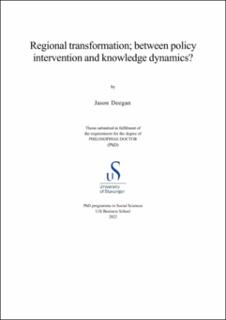| dc.description.abstract | Regions have emerged as an important spatial scale through which to understand processes of economic development (Lundvall, and Borrás, 1997; Asheim and Isaksen, 2002; Boschma, 2005, 2015; Boschma et al., 2017; Isaksen and Trippl, 2016; Neffke et al., 2011). This regional turn, however, has sought to provide answers to several important questions about how the process of economic development unfolds differently across regions, and more directly how and why it is that regions transform differently (Pike, Rodríguez-Pose and Tomaney, 2007; Trippl et al., 2020). Debates about how to understand regional transformation and the dimensions which contribute to the differing experience of regions are ongoing, with recent experiments in the realm of policy providing new sources of data and evidence to uncover important aspects of how regional transformation unfolds (Martin, 2010; Boschma et al., 2017).
Of particular concern to this thesis is how processes of regional transformation lead to economic growth. The relationship between the more quantitative focus on growth, versus the more qualitative focus on development, is discussed in greater detail in the work of Feldman et al. (2015) and further discussed in the more recent work of Feldman and Storper (2018), who highlight the frequency with which the terms of growth and development are often used interchangeably. Feldman and Storper (2018) further highlight that the terms frequently correlate in practice, such as in the example of per capita income (indicating growth) and the human development index (indicating development), which show strong correlation in the range of 0.95, for example. Furthermore, the authors highlight that the precise direction of causation between growth and development remains unclear (for example, does growth in income drive investment in education or does educational investment produce income growth). Here, then, economic growth tends to be a focus of macroeconomists who rely on the use of quantifiable metrics such as gross national product, as opposed to economic development which instead is typically concerned with infrastructure, public health, and education, for example.
What this current thesis is focused on is understanding how economic growth can be achieved through processes of regional transformation and the ways in which knowledge dynamics in a region can lead to innovation, which, in turn, can lead to productivity improvements, which, in turn, stimulate regional economic growth, and how it is that such changes in a region’s economy are stimulated through such processes of regional transformation. A core focus of this current research is on the structural changes which can take place in a regional economy, by, for example, focusing on the changes in sectoral and technological composition in a given region’s economy in order to understand this regional economic growth. Regional transformation, in this sense, can be considered a process whereby the economic activities, or portfolios of economic activities in a region, transform or change over time. The transformation process, then, can be seen as leading to regional economic growth, with the exact contributory factors of such an outcome being the subject of considerable scholarly attention (Glaeser et al., 1992; Frenken, Van Oort and Verburg, 2007; Beaudry and Schiffauerova, 2009; Isaksen and Trippl, 2016; Oinas, Trippl and Höyssä, 2018). The transformation then of regional economies varies markedly, with the outcomes of such processes of change remaining a phenomenon which plagues policymakers and scholars alike (Frenken, Van Oort and Verburg, 2007; Bellini, Lazzeri and Rovai, 2020; De Propris and Bailey, 2021). However, recent work has begun to provide greater clarity on the factors which go into the process of regional transformation, with the knowledge bases which exist in regions, alongside the respective role of policy, being an area of considerable promise in explaining the structural changes which produce broader regional transformation processes (Frenken, Van Oort and Verburg, 2007; Asheim, Moodysson and Tödtling, 2011; Borrás, 2011; Asheim, 2019; Trippl et al., 2020).
[...] | en_US |

